
| Songs and Poems of War |
Reviews |
|
Soprano Rachel Holland with Pianist Mary Hellmann Outside the weather was chilly with drizzle; inside the hall there was a friendly warmth and an art song recital with a piano soloist. The first set of songs, by Francis Poulenc (1899-1963), took us to Paris for an evening on the town and the closing set included songs on the theme of spring by four American composers. Between there was a Giacomo Puccini (1858-1924) aria and a world premiere of a vocal/electronic collaboration between singer Rachel Holland and composer Christopher Cook (b.1962).
Ms. Holland is greatly enthusiastic about Poulenc songs. Her large, luscious voice captured the sensuous happiness of Violon (Violin), a song that compares the relation of the player to his instrument to lovers: “the heart, shaped like a strawberry, gives itself to love like an unknown fruit.” Voyage à Paris, a brief, emphatic song, is the celebration of arriving in Paris coming from a dismal place. Les Chemins de l'Amour (The paths of love) is a cabaret waltz. It sounds like a popular song from the 50s sung by an American in a Paris nightclub. The pianist for the evening, Mary Hellmann, played Frédéric Chopin (1810-1849) Scherzo in b minor, Op. 20. It begins with two chords in fortissimo. At a tremendous speed a series of dramatic outbursts is followed by a slower section and eventually a tangible melody emerges. The playing was literal but the heavy pedal muddied the sound of quick notes. In my favorite recording by Sviatoslav Richter, the silences between the fast passages and the dramatic chords shape the experience. By definition, a scherzo is a joke or game or a quick, light movement related to a minuet and in triple time. The notes were all there but it felt like we heard six fragments that did not fit together - dramatic but unstructured. The final set of songs, on the theme of spring, was by American composers. Ms. Holland reached into the American song bag and pulled out four gems: Spring by Dominick Argento (b.1927), Rain in Spring by Ned Rorem (b.1923), Spring Song by Charles Ives (1874-1954) and finally Screw Spring by Richard Hundley (b.1931). The sweet rebirth in nature and the human heart are extolled in the first three selections. The contrarian in the group is the Hundley song. The wife in the song is distressed by her husband's exuberance at being outside to watch young women pass. She strives to hold on to their life in winter. Since it is only late January the wife will most likely have it her way, at least for a couple more months. Argento's setting takes us on a musical journey through the history of settings of spring songs. Rorem's specificity of text unfolds with no haste nor strain as the spring rain falls. The longing for rebirth in Ives' setting was sad and still unfulfilled. The singing was perfect, capturing the American human spirit in its several facets.
In the first song, No Man’s Land (aka Green Fields of France), Mr. Mooney was accompanied by piano, flute (Samantha Webber) and percussion (Zach Riviere). Written in 1976 by Scottish singer-songwriter Eric Bogle, it draws on two songs commonly played at funerals for soldiers. The song describes a visit by the composer to a French military cemetery, where he reflects on the waste and futility of war. One of the projected pictures was of a field of poppies and there were pictures of young WW I soldiers and a tombstone with a death date of 1916.
Mr. Mooney sang a Richard Pearson Thomas (b. 1957) song from his cycle Drum Taps: A Sight in Camp in the Daybreak Gray and Dim. It is a vivid description of the faces of three dead men covered by blankets on the field. Whitman uncovers each face by turn and gives his description of what he saw –a gaunt old man, a youth in the first blush of his manhood, and in the third he saw the face of Christ himself. Period photographs were the visual. In the second reading, by Christopher Tedrow, Whitman gives voice to a soldier who comes alive in The Real War Will Never Get in the Books. What interested Whitman was not the war described by patriotic rhetoric or politicians but rather the interior experience of the ordinary soldier.
The third reading was from A Last Word by Ernie Pyle (1900-1945), an American war correspondent who wrote about common soldiers and their experience in WW II. His reports were collected in book form. After being with the allies at the invasion of North Africa, Italy and Normandy, he was killed by Japanese sniper fire during the landing on Okinawa. A more recent song, Old Red Hills of Home by Jason Robert Brown (b.1970), was accompanied by a drum and piano with pictures of Confederate flags and young Southern men in uniform. The longing for home and the grand swell of Mr. Mooney’s voice left a vivid emotional impression. Tell My Father by Frank Wildhorn (b. 1958) from his cycle Civil War opened with guitar played by CNU student Will Fruchterman. The tune was a downhome country song with the text a letter home to a soldier’s father. The fourth reading, Union Private Arthur van Lisle at the Battle of Chickamauga (1863) was by Brandon Lareau. With precise, resonant voice he read the story of a Rebel soldier who gave his canteen to a wounded Union soldier on the battlefield. Emily DeWoolfson (b.1992) is a second year CNU composition student who wrote the next set of songs, Voices of the Civil War. She created vivid settings titled: Death was in the Air and Rock of Ages sung as a funeral party bears the fallen to the grave. The text of The Tale of the Great Rebellion is from a letter home; the writer is resigned to accept the inevitability of his death. The drum ending is like a gunshot to the listener’s soul. Mr. Crissman then read Corporal Stare by Robert Graves (1895-1985) from Fairies and Fusiliers. At a dinner for 500 soldiers the ghost of a sergeant killed is recalled. From a song cycle The Shropshire Lad by George Butterworth (1885-1916) we heard The Lads in Their Hundreds (lads who will die in their glory and will never be home) and Is My Team Ploughing? (the farmer who used to plow this land now lies under it). But still it is a hopeful story. Set as a dialogue between the lad under the ground and the man who had survived to grow-up, Mr. Mooney gave voice to both using a lighter, sweeter part of his voice for the dead youth in contrast to his usual deeper baritone for the survivor. The man had married the lad’s sweetheart and life had continuity.
The last reading, by Mr. Lareau, was from the book Jarhead by Anthony Swofford (b.1970) and was most visceral. Sitting there in the dark you realize that war will never end: human beings make war and will continue to do so. The closing song had the staged filled with handsome, enthusiastic, young men and women, the OMA Men’s Chorus with Paul Keene, conductor, and five young women as a chorus repeating Fare Well, the title of Irish composer C.V. Stanford’s (1852-1924) work. Mr. Mooney sang verses depicting naval combat and life as a sailor. Projected pictures were from CNN’s “Home and Away” initiative and were photos of the men and women of Tidewater who have died in the recent wars. To close, a line from the song: “Greet them again, with tender words and grave – for saving thee, themselves they could not save.” Back to Top |
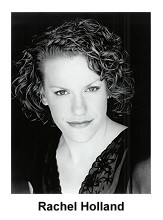 Siren Song, composed for Rachel Holland, is a work for soprano and electronics. Composer Cook described the process of creation: “The electronic sounds are largely created from recordings of Dr. Holland and were manipulated through a variety of computer processes to construct the ‘sound world’ for the composition. The Greek mythological Sirens, who lure sailors with their seductive voices to wreck on the rocky coast of their island, inspire the work. As her song emerges, she is accompanied by her own computer-enhanced voice adding an additional depth making her irresistible to sailors at sea! The harmonic overtones of the pitch ‘C’ are used to create the tonal world that she interacts with throughout the work. The voice is used instrumentally as she ‘vocalizes’ and no text is sung.”
Siren Song, composed for Rachel Holland, is a work for soprano and electronics. Composer Cook described the process of creation: “The electronic sounds are largely created from recordings of Dr. Holland and were manipulated through a variety of computer processes to construct the ‘sound world’ for the composition. The Greek mythological Sirens, who lure sailors with their seductive voices to wreck on the rocky coast of their island, inspire the work. As her song emerges, she is accompanied by her own computer-enhanced voice adding an additional depth making her irresistible to sailors at sea! The harmonic overtones of the pitch ‘C’ are used to create the tonal world that she interacts with throughout the work. The voice is used instrumentally as she ‘vocalizes’ and no text is sung.”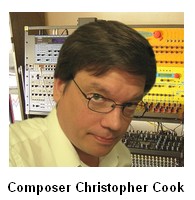 In the sound world they created you hear electronically created raindrops that merge with her voice. There is an unfettered opulence in the soundscape. You hear the crash of the ship lured to the Siren's island and the waves lapping on the shore afterward. Ms. Holland's pastel, mauve gown had layers of sheer fabric, a vision of the layer-upon-layer of sound as she glided around the stage, emerging from the darkness to sing beautifully, only to disappear once again. They created a lovely sense of expectation that was fulfilled. There are plans to repeat the piece in other venues. Unlike the first generation of electronic music that created fragments in space, Christopher Cook creates electronic sounds as an integrated musical experience.
In the sound world they created you hear electronically created raindrops that merge with her voice. There is an unfettered opulence in the soundscape. You hear the crash of the ship lured to the Siren's island and the waves lapping on the shore afterward. Ms. Holland's pastel, mauve gown had layers of sheer fabric, a vision of the layer-upon-layer of sound as she glided around the stage, emerging from the darkness to sing beautifully, only to disappear once again. They created a lovely sense of expectation that was fulfilled. There are plans to repeat the piece in other venues. Unlike the first generation of electronic music that created fragments in space, Christopher Cook creates electronic sounds as an integrated musical experience.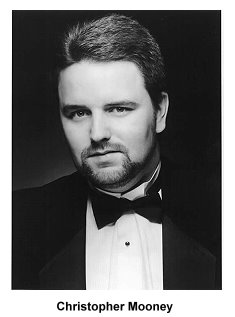 Chris Mooney was a magician on April 2nd. Piece by piece he built a picture of how it feels to be a soldier. Leilani Giles was at the piano. With a screen overhead at the front of the proscenium and a lectern on the left of the stage, the program began when 2011 graduate Scott Crissman appeared and read Anthem for a Doomed Youth by Wilfred Owen (1893-1918). In World War I, Owen was wounded and while he was recuperating, a friend encouraged him to write poetry about his experience. He depicted graphic images of the horrors of war. When he recovered he returned to the battlefield and was killed a week before the war ended.
Chris Mooney was a magician on April 2nd. Piece by piece he built a picture of how it feels to be a soldier. Leilani Giles was at the piano. With a screen overhead at the front of the proscenium and a lectern on the left of the stage, the program began when 2011 graduate Scott Crissman appeared and read Anthem for a Doomed Youth by Wilfred Owen (1893-1918). In World War I, Owen was wounded and while he was recuperating, a friend encouraged him to write poetry about his experience. He depicted graphic images of the horrors of war. When he recovered he returned to the battlefield and was killed a week before the war ended. The next songs and poems were by Walt Whitman (1819-1892), who was a volunteer nurse during the Civil War and was deeply affected, befriending wounded soldiers in hospital and on the fields of battle. Whitman’s graphic descriptions were called “obscene” and “overtly sexual” but he is a key shaper of our perspective on the Civil War and of our nation in the years after.
The next songs and poems were by Walt Whitman (1819-1892), who was a volunteer nurse during the Civil War and was deeply affected, befriending wounded soldiers in hospital and on the fields of battle. Whitman’s graphic descriptions were called “obscene” and “overtly sexual” but he is a key shaper of our perspective on the Civil War and of our nation in the years after.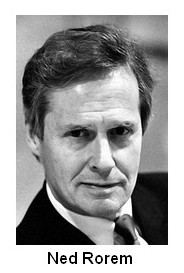 War Scenes (1969) by Ned Rorem is a five-song cycle with the last song a setting of The Real War Will Never Get in the Books . The other titles are A Night Battle, Specimen Case, An Incident and Inauguration Ball. The songs speak of fights, both on the battle field and for one’s life after being wounded. Inauguration Ball speaks of the psychological aftermath for Whitman of the war. The ballroom now filled with perfumed women and dancing had once been used as a hospital for “amputation, the blue face, the groan and glassy eye of the dying...” Rorem’s dedication on the score reads “To those who died in Vietnam, both sides, during the composition: 20-30 June, 1969.”
War Scenes (1969) by Ned Rorem is a five-song cycle with the last song a setting of The Real War Will Never Get in the Books . The other titles are A Night Battle, Specimen Case, An Incident and Inauguration Ball. The songs speak of fights, both on the battle field and for one’s life after being wounded. Inauguration Ball speaks of the psychological aftermath for Whitman of the war. The ballroom now filled with perfumed women and dancing had once been used as a hospital for “amputation, the blue face, the groan and glassy eye of the dying...” Rorem’s dedication on the score reads “To those who died in Vietnam, both sides, during the composition: 20-30 June, 1969.” 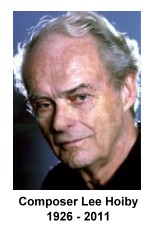 Mr. Tedrow then read Invasion by John Steinbeck (1902-1968) from his book Once There Was a War followed by another song, Private First Class Jesse Givens by Lee Hoiby (b.1926) with projected photos of military families greeting or saying goodbye, including at the end, a photo of the Givens family. The most gripping was a boy asleep on his Dad’s shoulder. A Last Letter Home, as the song has come to be known, was written to be opened only if he did not return. Writing to his five-year-old son he says “I will always be there with you.” But he is not. Hoiby dedicated his song to “the fallen of Iraq.”
Mr. Tedrow then read Invasion by John Steinbeck (1902-1968) from his book Once There Was a War followed by another song, Private First Class Jesse Givens by Lee Hoiby (b.1926) with projected photos of military families greeting or saying goodbye, including at the end, a photo of the Givens family. The most gripping was a boy asleep on his Dad’s shoulder. A Last Letter Home, as the song has come to be known, was written to be opened only if he did not return. Writing to his five-year-old son he says “I will always be there with you.” But he is not. Hoiby dedicated his song to “the fallen of Iraq.”